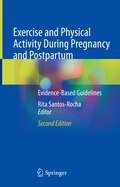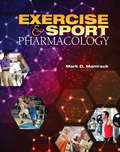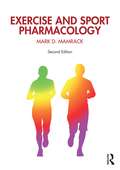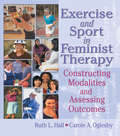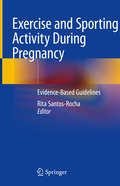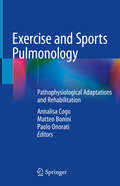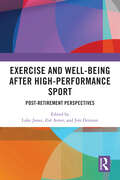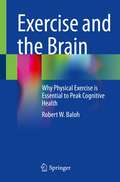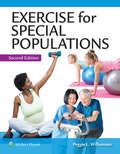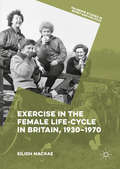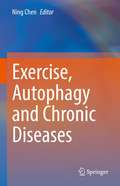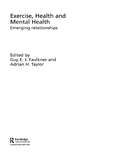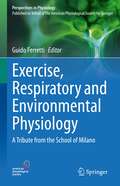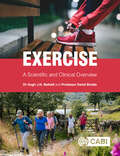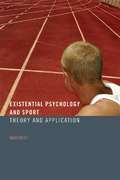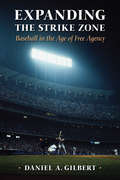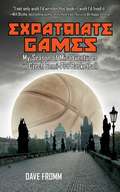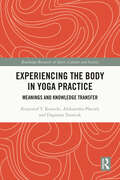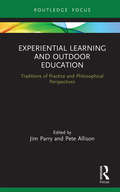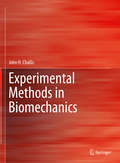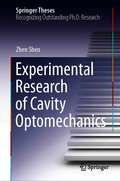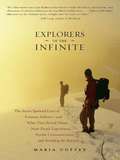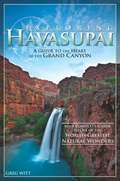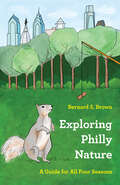- Table View
- List View
Exercise and Physical Activity During Pregnancy and Postpartum: Evidence-Based Guidelines
by Rita Santos-RochaThis is the second edition of a well-received, practice oriented, multidisciplinary book filling the gap between evidence-based knowledge on the benefits of physical activity and exercise during pregnancy and postpartum and the implementation of exercise programs and related health promotion measures in pregnant women.Readers will find up-to-date evidence on the psychological, social, physiological, body composition, musculoskeletal, and biomechanical changes that occur during pregnancy and their implications for physical activity and exercise. Further, the authors equip the reader with the latest guidelines and detailed description of exercise testing, prescription, selection and adaptation for pregnant and postpartum women, including those with clinical conditions.This new edition has been thoroughly updated, and includes additional chapters focused on the pedagogical intervention in pre and postnatal exercise programs, exercise prescription and adaptation during postpartum and diet recommendations for the pregnant exerciser and athlete. Written by recognized experts in the field, the book aims to allay undue fears regarding the consequences of exercising during pregnancy. Moreover, it provides medical, sports, and fitness professionals both with the knowledge and the practical expertise needed to offer an optimal guidance on exercising to pregnant exercisers and athletes.
Exercise and Sport Pharmacology
by Mark D. MamrackExercise and Sport Pharmacology is an accessible book that will be useful for teaching upper-level undergraduates or entry-level graduate students about how drugs can affect exercise and as well as how exercise can affect the action of drugs. It leads students through the science-including the related pathology, exercise physiology, and drug action-to gain an understanding of these interactions. The book is divided into four parts. Part I provides the basics of exercise pharmacology, exercise physiology, and autonomic pharmacology; Part II presents chapters on the major cardiovascular and respiratory drug classes; Part III describes the frequently prescribed medications for such common conditions as diabetes, depression, pain, fever, inflammation, and obesity; and Part IV includes discussions of supplements and commonly used drugs such as caffeine, nicotine, cannabis, and performance-enhancing drugs. In Parts II through IV, the chapters include an overview of the pathology the drugs are designed to treat, how the drug works in the human body, the effect of exercise on how the body responds to a drug, and how exercise changes the fate of the drug in the body. Chapters also include information on the drug's possible health risks and whether taking the drug comes under scrutiny of sport-regulating agencies.Throughout, figures and tables help to illustrate and summarize content. Most chapters open with an on-going case example to apply and preview chapter content. In the text, boldface terms indicate for students which concepts can be found in the book's Glossary, for easy reference. Chapters conclude with a Key Concepts Review and Review Questions.
Exercise and Sport Pharmacology
by Mark D. MamrackExercise and Sport Pharmacology is an essential book for teaching upper-level undergraduates or entry-level graduate students about how drugs can affect exercise and how exercise can affect the action of drugs. It leads students through the related pathology, exercise physiology, and drug action of many of today's chronically used medications, and discusses how drugs can affect exercise performance. This new second edition of the book is divided into four parts: Section I provides the basics of pharmacology, exercise physiology, autonomic pharmacology, and the stress response; Section II presents chapters on major cardiovascular and respiratory drug classes; Section III describes frequently prescribed medications for such common conditions as diabetes, depression, pain, fever, inflammation, and obesity; and Section IV includes discussions of nutritional supplements and commonly used drugs such as caffeine, nicotine, cannabis, and performance-enhancing drugs. The second edition offers many updates, enhances muscle cell physiology, includes the involvement of the gut microbiome, and each chapter has a new section on the effects of aging. In Sections II and III, chapters include an overview of the pathology that therapeutic drugs are designed to treat and how the drug works in the human body. In contrast to standard pharmacology texts, Exercise and Sport Pharmacology also includes the effect of exercise on the pathology of the condition and the effect of exercise on how the body responds to a drug. Each chapter has a section on whether the drugs under discussion have performance-enhancing potential. Section IV is concerned with self-medication and drugs or supplements taken without a prescription or with limited medical supervision. Throughout, figures and tables as well as data from experiments in exercise pharmacology help to illustrate and summarize content. Each chapter opens with an on-going case example to preview and apply chapter content. In the text, boldface terms indicate which concepts are contained in the book's Glossary. Chapters conclude with a Key Concepts Review and Review Questions.
Exercise and Sport in Feminist Therapy: Constructing Modalities and Assessing Outcomes
by Ruth Hall Carole OglesbyIntegrate physical activity into feminist therapy!This book explores the healing use of exercise and sport as a helpful adjunct to therapy from several therapeutic orientations within the feminist context. It looks at the ways that feminist orientations challenge the mind-body dichotomy and explores the benefits of integrating physical activity, exercise, and sport into therapy. From the editors: "The contributors to this book display a diversity of theory and research approaches, including the integration of the exercise/sport sciences and exercise physiology. This volume is unique in that there has been comparatively little written about the use of exercise in therapy even though exercise is a wonderful and useful intervention tool in the treatment of depression, stress, anxiety disorders, and chronic pain. This book illustrates how exercise can be applied to inpatient and outpatient populations, to the neurotic, and to the chronically mentally ill. Exercise can reduce the incidence of chronic diseases, including diabetes and hypertension, as well as address physical problems such as obesity. Exercise can give one a sense of mastery and self-confidence. As our authors suggest, exercise must be tailored to specific issues and client populations and diagnoses, level of functioning, age, overall health, and cultural context must all be taken into account."Exercise and Sport in Feminist Therapy: Constructing Modalities and Assessing Outcomes examines: the theory supporting the use of physicality to enhance various types of psychotherapy-psychoanalytic, cognitive-behavioral, constructivist, narrative, and organismic/systems practical methods of integrating exercise into varied orientations an exercise program for women with fibromyalgia a way to use exercise to enhance rehabilitation from breast cancer the use of exercise in group therapy for women suffering with chronic mental illness the “tend and befriend” model, which can help clients to meet their exercise program responsibilities
Exercise and Sporting Activity During Pregnancy: Evidence-Based Guidelines
by Rita Santos-Rocha<p>This clinically and practice oriented, multidisciplinary book is intended to fill the gap between evidence-based knowledge on the benefits of physical activity and exercise during pregnancy and the implementation of exercise programmes and related health promotion measures in pregnant women. It will provide medical, sports, and fitness professionals both with the knowledge needed to allay undue fears regarding the consequences of exercising during pregnancy and with the practical expertise to offer optimal guidance on exercising to pregnant exercisers and athletes. <p>Readers will find up-to-date evidence on the psychological, social, physiological, body composition, musculoskeletal, and biomechanical changes that occur during pregnancy and their implications for physical activity and exercise. Detailed descriptions are provided of the components of exercise testing and prescription for pregnant women, the current evidence-based and practice-oriented guidelines, and exercise selection and adaptation during pregnancy. Exercises specifically targeting musculoskeletal health are discussed separately, and a concluding chapter explains the nutritional requirements in pregnant women who exercise.</p>
Exercise and Sports Pulmonology: Pathophysiological Adaptations and Rehabilitation
by Annalisa Cogo Matteo Bonini Paolo OnoratiThis book provides an innovative and comprehensive overview of the relationship between lung and exercise, both in healthy, active subjects and in subjects with chronic respiratory diseases. It investigates in detail the central role of the lungs during exercise and illustrates the impact of respiratory impairment due to both acute and chronic lung diseases on performance. Further, the book presents the latest evidence-based findings, which confirm that exercise is an effective and safe form of prevention and rehabilitation in respiratory diseases.The first section describes the changes in the respiratory system during exercise and the contribution of respiration to exercise, while readers will learn how to perform a respiratory assessment in the second section. The third section addresses a broad range of chronic respiratory diseases and the (in)ability of those affected to play sports and perform exercise, thus providing a basis for individual assessments. The last two sections focus on respiratory training, rehabilitation and the relationship between respiration and the environment, e.g. in high-altitude and underwater sports. The book will appeal to a wide readership, including pulmonologists, sport medicine physicians, physiotherapists and trainers, as well as instructors and students in exercise science.
Exercise and Well-Being after High-Performance Sport: Post-Retirement Perspectives
by Luke Jones, Zoë Avner, and Jim DenisonExercise and Well-Being after High-Performance Sport explores whether high-performance athletes have healthy and prosperous relationships with exercise and wellbeing after retirement from elite sports. This edited collection is the first of its kind to bring together sociologically informed accounts from former high-performance athletes about their retirement experiences and post-sporting careers. The chapters combine creative narrative writing and social theory to frame the experiences of exercise and wellbeing after retirement from high-performance sport. Written by former high-performance athletes who are now socio-cultural sports’ scholars, the authors explore how retiring from elite sport impacted their relationship to exercise and physical activity, identity, and long-term mental health. This book is key reading for graduate and postgraduate students, as well as academics and researchers interested in sports retirement experiences, sport sociology, mental health, and wellbeing.
Exercise and the Brain: Why Physical Exercise is Essential to Peak Cognitive Health
by Robert W. BalohThis book focuses on the benefits of exercise for prevention and treatment of chronic brain disorders. It is a guide for finding the right exercise routine for each individual. The goal is to show the reader why everyone needs to exercise, especially as we get older. The brain needs physical exercise both for normal health and for preventing and treating diseases common with aging.How much exercise is needed? As we see throughout the book there is no one fits all rule with regard to the amount of exercise required. The key is to make exercise a part of one’s daily routine. The beneficial effect of exercise is transient, lasting days to weeks, so it must be a lifelong pursuit. Can we exercise too much? Anything done in excess can potentially be dangerous but with the common sense approach outlined in this book anyone, regardless of underlying health condition, can find some type of exercise that is safe and effective.
Exercise for Special Populations
by Peggie WilliamsonPublisher's Note: Products purchased from 3rd Party sellers are not guaranteed by the Publisher for quality, authenticity, or access to any online entitlements included with the product. This updated 2nd Edition of Williamson’s highly applied Exercise for Special Populations provides just enough background for practicing and future personal trainers, exercise physiologists, and other health and fitness professionals to develop and implement exercise programs for special populations. For each condition, the book provides a general description, anatomy and physiology variances, precautions, recommendations for exercise testing and prescription, instructions and images of various exercises, and nutritional considerations. Reflecting the latest best practices in the field, the 2nd Edition features new chapters and pedagogy and a powerful suite of online resources.
Exercise in the Female Life-Cycle in Britain, 1930-1970
by Eilidh MacraeThis book examines how adolescence, menstruation and pregnancy were experienced or 'managed' by active women in Britain between 1930 and 1970, and how their athletic life-styles interacted with their working lives, marriage and motherhood. It explores the gendered barriers which have influenced women's sporting experiences. Women's lives have always been shaped by the socially and physically constructed life-cycle, and this is all the more apparent when we look at female exercise. Even self-proclaimed 'sporty' women have had to negotiate obstacles at various stages of their lives to try and maintain their athletic identity. So how did women overcome these obstacles to gain access to exercise in a time when the sportswoman was not an image society was wholly comfortable with? Oral history testimony and extensive archival research show how the physically and socially constructed female life-cycle shaped women's experiences of exercise and sport throughout these decades.
Exercise, Autophagy and Chronic Diseases
by Ning ChenThis book establishes a bridge between exercise-mediated functional status of autophagy and non-communicable chronic diseases for elucidating and clarifying the corresponding signal pathways and underlying mechanisms. The book consists of 13 chapters focusing on the in-depth discussion on signal pathways for regulating the functional status of autophagy for the prevention, treatment and rehabilitation of chronic diseases, the optimization of exercise intervention strategies for common and frequently-occurring chronic diseases, and the development of exercise mimetic pills for the persons with disability for exercise performance, or the persons without willing to exercise. This book is interesting and will be useful to a wide readership in the various fields of exercise science, exercise fitness, sports medicine, preventive medicine, and functional foods.
Exercise, Health and Mental Health: Emerging Relationships
by Guy E.J. Faulkner Adrian H. TaylorExercise, Health and Mental Health provides an introduction to this emerging field and a platform for future research and practice. Written by internationally acclaimed exercise, health and medical scientists, it is the first systematic review of the evidence for the potential role of exercise in: treating and managing mental health problems including dementia, schizophrenia, drug and alcohol dependence coping with chronic clinical conditions including cancer, heart disease and HIV/AIDS enhancing well-being in the general population – by improving sleep, assisting in smoking cessation, and as a way of addressing broader social issues such as anti-social behaviour. Adopting a consistent and accessible format, the research findings for each topic are clearly summarized and critically examined for their implications.
Exercise, Respiratory and Environmental Physiology: A Tribute from the School of Milano (Perspectives in Physiology)
by Guido FerrettiThis book sheds new light on the history of exercise physiology and how it essentially grew, thanks to the work of a few major Schools. Analysing and interpreting the evolution of the field, the authors focus on the School of Milano, which was founded by Rodolfo Margaria and is one of the most prominent representatives, having played a central role in promoting and advancing this field of physiology. In turn, the authors trace Margaria’s biography; under his influence, the school introduced new concepts with regard to both the energetics of muscular exercise and to human locomotion. These concepts were further developed by Margaria’s pupils and by subsequent generations. Indeed, the course that was set in Milano greatly influenced the entire history of modern physiology. Readers with a keen interest in the origins of modern concepts and technologies in exercise physiology will find this book a fascinating and informative read.
Exercise, Sports and Hypertension (Updates in Hypertension and Cardiovascular Protection)
by Giuseppe Mancia Enrico Agabiti-Rosei Paolo PalatiniThis book presents the current knowledge on the mechanisms by which exercise lowers blood pressure in hypertension and on its effects on the heart and arteries. In addition, it focuses on the optimal exercise protocols, the international consensus on clinical implementation, and the clinical indications for special populations (obese, diabetic etc). It also addresses possible drawbacks of exercise on left ventricular structure and function. Many experts in epidemiology, patophysiology and clinical research have contributed in preparing the chapters, with the main purpose of guiding clinicians in the optimal application of the present knowledge and to stimulate scientists to fill the gaps in knowledge by performing further research.The book is addressed not only to specialists in Hypertension, Internal Medicine, Cardiology, Metabolism, and Nephrology, but also to general practitioners and all healthcare professionals working in the field of rehabilitation medicine.
Exercise: A Scientific and Clinical Overview
by Dr Hugh J. Bethell Professor David BrodieThis book is about exercise - what it is, how it affects the individual, how it is measured and most of all what benefits it brings. Beginning with an introduction to the history and biology of exercise, the authors review the interactions between exercise and specific diseases, such as diabetes, coronary heart disease, cancer and many more, before considering exercise in a wider health context. The book covers: - Current societal norms, as well as the social and economic costs of inactivity. - Exercise for life - from starting young, to pregnancy, longevity and frailty. - Complications of exercise. - The intersections of behavioural psychology and exercise, such as encouragement and excuse making. With comprehensive and clear explanations based on sound science, yet written in an approachable and accessible style, this book is a valuable resource for students of medicine, public health, physiotherapy, sports science, coaching and training.
Existential Psychology and Sport: Theory and Application
by Mark NestiIncreasing numbers of professional teams and athletes look for assistance with the psychological factors of their performance, and there exists a growing body of professional sport psychologists ready to provide support. Despite this, it seems at times there remains a significant gap between the real needs of sport performers and what is delivered by traditional sport psychology. The existential approach described by Mark Nesti offers a radical alternative to the cognitive and cognitive-behavioural approaches that have dominated sport psychology, and represents the first systematic attempt to apply existential psychological theory and phenomenological method to sport psychology. This much-needed alternative framework for the discipline of applied sport psychology connects to many of the real and most significant challenges faced by sports performers during their careers and beyond. Existential Psychology and Sport outlines an approach that can be used to add something of depth, substance and academic rigour to sport psychology in applied settings beyond the confines of MST and good listening skills.
Expanding the Strike Zone: Baseball in the Age of Free Agency
by Daniel A. GilbertWith its iconic stars and gleaming ballparks, baseball has been one of the most captivating forms of modern popular culture. In Expanding the Strike Zone, Daniel A. Gilbert examines the history and meaning of the sport's tumultuous changes since the mid-twentieth century, amid Major League Baseball's growing global influence. From the rise of ballplayer unionism to the emergence of new forms of scouting, broadcasting, and stadium development, Gilbert shows that the baseball world has been home to struggles over work and territory that resonate far beyond the playing field. Readers encounter both legendary and unheralded figures in this sweeping history, which situates Major League Baseball as part of a larger culture industry. The book examines a labor history defined at once by the growing power of big league stars--from Juan Marichal and Curt Flood to Fernando Valenzuela and Ichiro Suzuki--and the collective struggles of players working to make a living throughout the baseball world. It also explores the territorial politics that have defined baseball's development as a form of transnational popular culture, from the impact of Dominican baseball academies to the organized campaign against stadium development by members of Seattle's Asian American community. Based on a rich body of research along with new readings of popular journalism, fiction, and film, Expanding the Strike Zone highlights the ways in which baseball's players, owners, writers, and fans have shaped and reshaped the sport as a central element of popular culture from the postwar boom to the Great Recession.
Expatriate Games: My Season of Misadventures in Czech Semi-Pro Basketball
by David FrommWhen Dave Fromm graduated from college with good grades and high LSAT scores, he planned to apply to law school. But he actually wasn't that sure he wanted to go, at least not right away. A few years earlier, he'd been to Prague for a weekend, and played a game of pickup basketball there. And he was a decent basketball player, though not good enough to make the team at Boston College either time he'd tried out. So he did the kind of thing we'd all do if we had the guts (and a foolhardy sense of determination) - he moved to Prague, even though he didn't speak Czech, or know anyone who'd been to Prague, or if they had basketball leagues there, much less professional leagues, much less if they let foreigners play.Expatriate Games is Dave Fromm's touching and amusing memoir of the year (1994) he spent playing basketball for TJ Sokol Kralovske Vinhorady, a Czech semi-pro team. Throughout, Fromm, a self-proclaimed "gym-rat," struggles with his teammates, the European style of play, and the language barrier. But miraculously, Fromm describes how despite the struggles the team came together, a girl appeared, and he was introduced to a side of Prague most foreigners can't--a Prague full of ghosts and back alleys and a people simultaneously embracing and reeling from transition.
Experiencing the Body in Yoga Practice: Meanings and Knowledge Transfer (Routledge Research in Sport, Culture and Society)
by Krzysztof T. Konecki Aleksandra Płaczek Dagmara TarasiukExperiencing the Body in Yoga Practice inspires more mindful and contemplative qualitative research on body and knowledge transfer in bodily practices in hatha yoga. The book explores the work of the mind, as well as the role of emotions and body sensations in perceiving reality and in reflecting on it. Procedures and research methods are an extension of our mind, which wants to reach into the social reality to describe it objectively. It usually refuses body and emotions. The techniques of sampling and representativeness are also tools of the mind. Using these tools, our contact with social reality produces emotions and feelings of the body. These phenomena surrounding the mind and body often go unnoticed during research and are only partially reported in the conclusions. Experiencing the Body in Yoga Practice examines this gap. It presents the application of a contemplative way of thinking and proceeding in qualitative social research and a first-person perspective, focusing on experiencing lived body and knowledge transfer in hatha yoga. It analyzes how the mind focuses and stops working, proceeds in the limited province of the meaning of yoga, how the body produces emotions and deals with them during yoga sessions, and how the knowledge is transferred by using the body in some linguistic and cultural context. The book will be of interest to sociologists and social scientists who want to concentrate on and analyze the experiences of the body from contemplative and phenomenological perspective. It is also key reading for all practitioners dealing with body and bodywork, such as in sports, recreational activities, physical education, rehabilitation, physical work, educational activities, etc.
Experiential Learning and Outdoor Education: Traditions of practice and philosophical perspectives
by Jim Parry Pete AllisonThis book adds to the theoretical development of the emerging fields of experiential learning and outdoor education by examining the central concept, 'experience', and interrogating a central claim of experiential learning: whether, and if so how, a short-term singular experience can transform a participant’s life as a whole and in a permanent way. While such a possibility has been corroborated by the personal testimonies of participants, and the activities of instructors over many years, the book argues that we must go beyond this kind of ‘evidence’. In comparing Anglophone and continental approaches and drawing on the work of Dewey, Dilthey and Merleau-Ponty in the philosophy of experience, Experiential Learning and Outdoor Education presents the first detailed review of the concept of ‘experience’ in European philosophy, as applied to outdoor experiential learning. A vital insight into the field, this is important reading for students and researchers working in the philosophy of sport, and pedagogical theory, especially in areas relating to the outdoors, but also to experiential education more generally.
Experimental Methods in Biomechanics
by John H. ChallisThis is the first textbook to comprehensively cover the experimental methods used in biomechanics. Designed for graduate students and researchers studying human biomechanics at the whole-body level, the book introduces readers to the theory behind the primary data collection methods and primary methods of data processing and analysis used in biomechanics. Each individual chapter covers a different aspect of data collection or data processing, presenting an overview of the topic at hand and explaining the math required for understanding the topic. A series of appendices provide the specific math that is required for understanding the chapter contents. Each chapter leads readers through the techniques used for data collection and processing, providing sufficient theoretical background to understand both the how and why of these techniques. Chapters end with a set of review questions, and then a bibliography which is divided into three sections (cited references, specific references, and useful references).Provides a comprehensive and in depth presentation on methods in whole-body human biomechanics;First textbook to cover both collection and processing in a single volume;Appendices provide the math needed for the main chapters.
Experimental Research of Cavity Optomechanics (Springer Theses)
by Zhen ShenThis thesis presents experimental research on the interaction between the optical field and the mechanical oscillator in whispering-gallery mode microcavities. It demonstrates how optomechanical interactions in a microresonator can be used to achieve non-magnetic non-reciprocity and develop all-optically controlled non-reciprocal multifunctional photonic devices. The thesis also discusses the interaction between the travelling optical and mechanical whispering-gallery modes, paving the way for non-reciprocal light storage as a coherent, circulating acoustic wave with a lifetime of up to tens of microseconds. Lastly, the thesis presents a high-frequency phase-sensitive heterodyne vibrometer, operating up to 10 GHz, which can be used for the high-resolution, non-invasive mapping of the vibration patterns of acoustic devices. The results presented here show that optomechanical devices hold great potential in the field of information processing.
Explorers of the Infinite
by Maria CoffeyReal-life psychic, near-death, and paranormal experiences are combined with cutting-edge science and vivid adventure stories in this energetic look at why extreme athletes and mountaineers take the risks that allow them to push the limits of consciousness, and what they encounter there. In the life-or-death world of extreme adventure sports, there is one thing that athletes often keep quiet about: the #147;forbidden” territory of paranormal experiences. Ranging from fleeting moments of transcendence to full-blown encounters with ghosts and everything in between#151;visions, near-death experiences, psychic communication#151;many extreme athletes have experienced these moments of connection with the beyond, but have been reluctant to talk about them. In Explorers of the Infinite, award-winning outdoors journalist and lifelong adventure sports devotee Maria Coffey probes the mystical and paranormal experiences of mountaineers, snowboarders, surfers, and more. She reviews cutting-edge science, and consults the history of philosophy and spirituality to answer the question: Could the state of intense #147;aliveness” that is the allure of extreme sports for so many actually be a route to a connection with the beyond? Coffey investigates the scientific explanations for mystical phenomena, ranging from simple explanations to theories from consciousness studies and quantum physics, and leaves us wondering where science ends and spirituality begins. An energetic, you-are-there look at the spiritual lives of extreme athletes, Explorers of the Infinite asks why extreme athletes take the risks that allow them to push the limits of consciousness, what they encounter there, and what we can learn from them.
Exploring Havasupai
by Greg WittDeep in the Grand Canyon lies a place of unmatched beauty; a place where blue-green water cascades over fern-clad cliffs into travertine pools, where great blue heron skim canyon streams, and where giant cottonwoods and graceful willows thrive in the shade of majestic sandstone cliffs. Havasupai is a paradise enveloped in one of the earth's most rugged and parched landscapes. The Havasupai Tribe has never advertised its canyon and has never endorsed a guidebook to prepare visitors for a journey into the Heart of the Grand Canyon - until now. Exploring Havasupai is the essential destination guide for those visiting the area. The guidebook is filled with insider tips, fascinating background, and essential information. It identifies many new hikes, mines, springs and historical sites never before revealed in a Grand Canyon or Havasupai guidebook. Details on canyon geology, weather patterns, and the unique flora and fauna add depth to a hiker's experience. Exploring Havasupai includes detailed maps, trail descriptions, stunning full-color photographs, and intriguing historical insights. This is the must-have guide for canyon visitors, whether arriving by helicopter, on horseback, or on foot.
Exploring Philly Nature: A Guide for All Four Seasons
by Bernard S. BrownDo snakes and salamanders fascinate you or make you squeamish? Have you ever listened closely to the birds chirping in your neighborhood? Can you identify the flowers growing in Philadelphia’s urban parks? (Moreover, are the mushrooms safe to eat?) Exploring Philly Nature is amateur naturalist, urban herper,* and Grid contributor Bernard Brown’s handy guide to experiencing the flora and fauna in Philly. This compact illustrated volume contains 52 activities from birding, (squirrel) fishing, and basement bug-hunting to joining a frog call survey and visiting a mussel hatchery. Brown encourages kids (as well as their parents) to connect with the natural world close to home. Each entry contains information on where and when to participate, what you will need (even if it is only patience), and tips on clubs and organizations to contact for access. The city and its environs contain a multitude of species from the lichen that grows on gravestones or trees to nocturnal animals like opossums, bats, and raccoons. Exploring Philly Nature is designed to get readers eager to discover, observe, and learn more about the concrete jungle that is Philadelphia.
